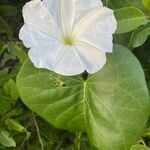A tuberous rooted vine with large round leaves. It is a vigorous climber reaching 4-5 m high. The vine is irregular in cross section. The leaves are large and rounded. They are 9-15 cm across. The leaf stalk is 6-12 cm long. The flowers can occur as one or several together. The sepals become large and fleshy in the fruit. The capsule is a large dry one with a fleshy lid and has 4 or less black seeds inside. The seeds are 8 mm long by 12 mm wide.
Corolla salver-shaped or very narrowly funnel-shaped, white and/or pale greenish-yellow, opening about mid-night; tube 7–8·5 cm. long; limb 2–4 × 5–6 cm., Capsule globose, 2–3 cm. in diam.
Flowers usually solitary, rarely in few-flowered cymes; peduncle 0·75–7 cm. long; pedicels 1·5–3 cm. long, becoming much thickened in fruit; bracts small, deciduous.
Leaf lamina circular to ovate, 5–16 × 5–14 cm., acuminate or cuspidate and mucronulate at the apex, deeply cordate at the base; petiole 3·5–8 cm. long.
Seeds subtrigonous more or less 1 cm. long, black, densely short tomentose and with a narrow ridge of longer hairs more or less 3–6 mm. long.
Sepals subequal, elliptic, 1·6–2 cm. long, attaining 3 cm. in fruit, obtuse at the apex, margins hyaline, coriaceous.
Stems twining or prostrate, terete or angular, often longitudinally wrinkled but otherwise smooth, ochraceous.
A glabrous perennial herb.

